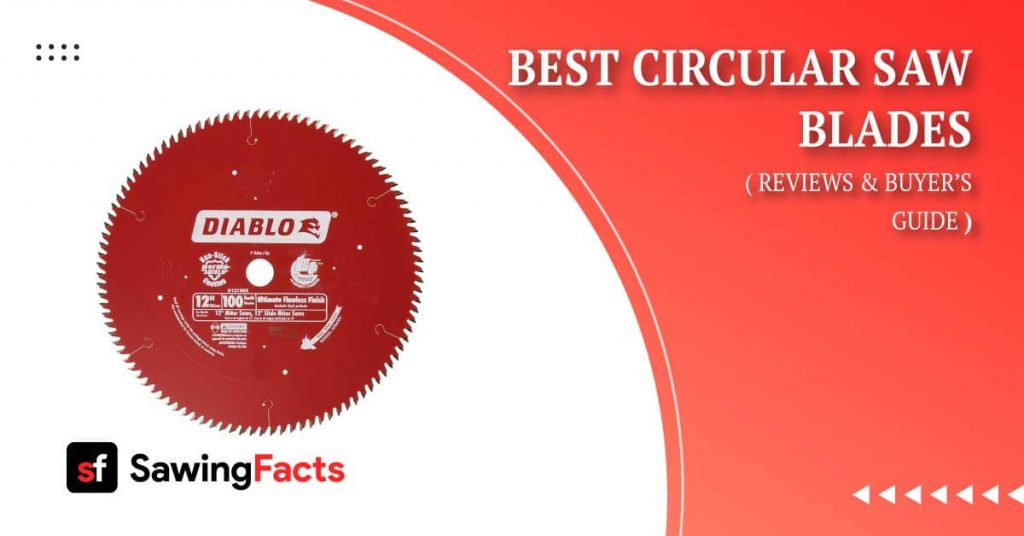Do you find woodworking projects to be exhausting? If yes, I feel your pain. But have you considered that it may be because you’re not using a circular saw blade yet? These blades can really help you complete your work in the blink of an eye.
Now, circular blades are actually sub-tools. As part of the regular hand-held circular saws, these sharp and efficient objects make cutting down hard objects a piece of cake. Depending on the type of blade, the primary tool is used for different purposes.
There are many circular saw blade types available in the market. Each one has its own advantages and disadvantages according to specifications and uses. Want to know more about them? Then keep on reading!
Table of Contents
What Is a Circular Saw Blade?
A circular saw blade is a sharp blade made of a tough, resilient metal compound and is used, as the name suggests, in circular saws. It can be made from various components and generally have different kinds of “teeth” on the blade’s edge.
Although many materials are used to make a circular saw blade, the most commonly used is steel. Steel and its variants make strong saw blades that can withstand rough use and most conditions.
Different Circular Saw Blades Types
Here, we present types of circular saw blades classified into two categories – based on blade type and the type of material to be cut.
Based on Blade Type
Ripping Blades
Ripping blades are the most common type of blades out they are. These blades with deep gullets can produce rough cuts quite quickly.
Combination Blades
Combination blades can produce fairly smooth cuts. As for functionality, these multipurpose blades can create both rip cuts and crosscuts.
Thin Kerf Blade
Thin kerf blades cut the wood or concerning material to narrow pieces. It is better to use it on fine, more brittle particles.
Crosscutting Blade
As these blades have a comparatively greater number of teeth, they have deeper gullets. You can use these to create cross cuts over the material.
Based on Type of Material to Be Cut
Wood
For wood, a steel-made blade is the best option. These inexpensive blades can cut through almost any type of wood. However, they lose their edge quickly.
Plywood
For plywood and other conditioned wood, any blade with a thicker kerf will do. Using it, you will be able to cut vertical lines perfectly.
Plastic
Not every blade can cut plastic. For plastic, it is ideal to choose a blade with a high number of teeth.
Metal
For metals, some specialized blades are used. The tooth is absent in these blades. Instead, expansion slots are present.
How to Choose the Perfect Circular Saw Blade?
To choose the perfect circular saw blade, you have to keep several factors in mind. Here are some of those factors mentioned.
Material
Material is the most crucial factor you should consider. Here, both the blade’s material and the object’s material to be cut should be examined.
Not all blades are suitable for all materials. If you try to use a blade used for a softer material on a harder one, not only will it fail to work, but it will also be damaged. It is vital to match blades with the materials and use strong blades.
Size
Circular saw blades come in different sizes. There are both regular and mini sizes. Match your blade size with your saw and use it accordingly.
Cut
There are several kinds of cuts you can do with a saw blade. You can make straight cuts, crossway cuts, etc. If you need to perform a particular type of cut, make sure you get a blade that specializes in it.
Expected Performance
We know that there are different types of cuts. But these cuts also provide a different kind of finishing. Some cuts are used to rip pieces apart roughly. On the other hand, some are for finishing and polishing. Choose the blade according to your required performance.
Teeth Number
Teeth number is directly proportional to the speed of cutting. If you use a blade with more teeth, you will be able to get clear and concise cuts. A blade with fewer teeth will produce a rougher cut.
Gullet Shape
Between each tooth of a saw blade, there is a space. This space is known as a gullet. Gullet shape is an essential factor to be considered because it directly denotes how deep the cut can get.
If the gullets are ample in size, the saw will be able to remove larger chunks of material. Smaller gullets can help remove the uppermost layer of the particle.
Circular Saw Blades & Safety
Circular saws are high-performance power tools. Their blade is sharp, and most of the power is exerted on them. If not handled properly, it can cause severe damages and injuries. As a user, you need to be cautious while operating one.
Make sure that you go through the user guide before using a circular saw blade, or any such dangerous tool, for that matter. Get acquainted with all the features and functions of the tool first. Then, give it a test run before using it on your material.
Finally, always wear protective coverings on while using the tool. Even if it is not possible to cover your entire body, make sure you protect your eyes and ears. It is also ideal for a user to wear gloves during machine operation.
Conclusion
Dear enthusiasts, this is all we had for you! Now that you know about different circular saw blade types, we hope you can make good use of this knowledge.
Circular saw blades are both valuable and high-risk tools at the same time. Therefore, you must research thoroughly about them before using them.
And always remember that safety is as important as performance. All the best!

